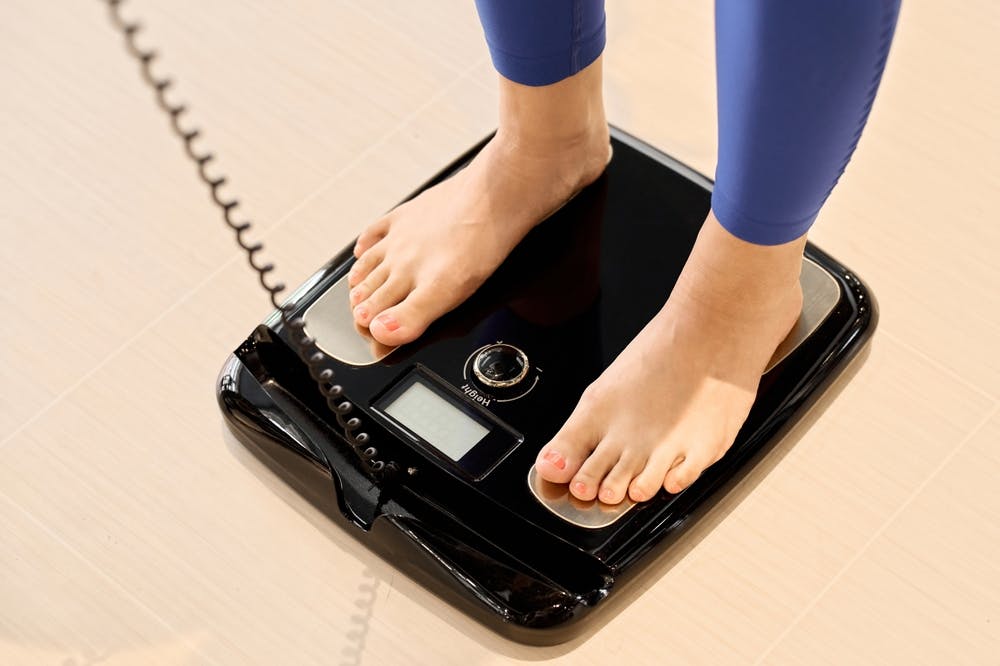A Comprehensive Guide to Reducing Visceral Fat for Better Health
By Lilian E.
Reviewed by Dr. Daniel Uba, MD
Published Apr 3, 2025
Updated Apr 8, 2025
7 min read

Visceral fat isn’t just the stubborn fat you can pinch—it’s the dangerous fat that wraps around your internal organs, increasing the risk of chronic diseases like diabetes, heart disease, and metabolic disorders. Unlike subcutaneous fat (the fat under your skin), visceral fat is hidden deep within your abdomen, making it harder to detect but far more harmful.
At Meto, we believe in sustainable, science-backed strategies to help you shed visceral fat and improve your overall health. This guide will cover everything you need to know—from what visceral fat is, why it’s dangerous, and most importantly, how to get rid of it effectively.
What Is Visceral Fat?
Visceral fat is a type of body fat stored within the abdominal cavity, surrounding vital organs like the liver, pancreas, and intestines. Unlike subcutaneous fat, which lies just beneath the skin, visceral fat is metabolically active, meaning it releases hormones and inflammatory substances that can disrupt bodily functions.
Visceral Fat vs. Subcutaneous Fat
- Visceral Fat: Located deep inside the abdomen, linked to metabolic diseases.
- Subcutaneous Fat: Found just under the skin, less harmful but harder to lose.
Why Is Visceral Fat Dangerous?
Excess visceral fat is a silent health threat because it:
- Increases insulin resistance, raising the risk of type 2 diabetes.
- Triggers inflammation, contributing to heart disease and stroke.
- Disrupts hormone balance, affecting hunger signals and fat storage.
- Raises bad cholesterol (LDL) and lowers good cholesterol (HDL).
- Is linked to certain cancers, including breast and colorectal cancer.
Research shows that even individuals at a "normal" BMI can have high visceral fat levels, making it crucial to monitor and manage.
Causes of Excess Visceral Fat:
Several factors can contribute to the accumulation of visceral fat:
- Diet: Excessive intake of sugary drinks, refined carbohydrates, and unhealthy fats promotes visceral fat storage.
- Physical Inactivity: A sedentary lifestyle combined with a high-calorie diet leads to unburned calories being stored as visceral fat.
- Stress: Chronic stress elevates cortisol levels, a hormone that triggers the body to store belly fat.
- Genetics: Some people are genetically predisposed to store more visceral fat than others.
- Age: As we age, our metabolism slows down, making it easier to accumulate visceral fat, particularly around the abdomen.
- Lack of sleep (disrupts hunger hormones like ghrelin and leptin).
- Certain Medications: Some medications, like corticosteroids, can lead to weight gain and increased visceral fat.
Symptoms of Excess Visceral Fat
While visceral fat often goes unnoticed, some indicators may suggest its presence:
- Increased abdominal girth
- Difficulty breathing during exertion
- High blood pressure
- Difficulty sleeping
How to Measure Visceral Fat

Visceral fat is not easily visible from the outside, making it crucial to measure it accurately. Unfortunately, there's no simple, non-invasive way to directly measure visceral fat. Since you can’t see visceral fat, how do you know if you have too much? Here are the best ways to assess it:
1. Waist-to-Hip Ratio (WHR)
- Measure your waist (narrowest part) and hips (widest part).
- Divide waist size by hip size.
- High-risk WHR: Above 0.85 for women or 0.90 for men.
2. Waist Circumference
- Women: Over 35 inches indicates high visceral fat.
- Men: Over 40 inches suggests excess visceral fat.
3. Body Scans (Most Accurate)
- DEXA Scan: Measures fat distribution.
- MRI/CT Scan: Provides detailed imaging of fat around organs.
Health Risks of Visceral Fat
Visceral fat is not just a cosmetic concern; it poses serious health risks. The metabolically active nature of visceral fat makes it a significant health concern. It's linked to various chronic diseases, including:
- Type 2 Diabetes: Visceral fat disrupts insulin sensitivity, making it harder for your body to regulate blood sugar levels.
- Cardiovascular Disease: Visceral fat releases inflammatory chemicals that contribute to the buildup of plaque in arteries, increasing the risk of heart attack and stroke.
- Metabolic Syndrome: This cluster of conditions, including high blood pressure, high blood sugar, and unhealthy cholesterol levels, is strongly associated with visceral fat.
- Certain Cancers: Research suggests a link between visceral fat and an increased risk of colorectal, pancreatic, and breast cancers.
- Insulin Resistance: Visceral fat can lead to insulin resistance, which is a precursor to type 2 diabetes.
Effective Ways to Reduce Visceral Fat
1. Optimize Your Diet
A nutrient-dense, whole-foods-based diet is the most effective way to combat visceral fat.
Foods That Help Burn Visceral Fat:
- High-fiber foods (oats, broccoli, lentils) – Reduce fat absorption.
- Lean proteins (chicken, fish, tofu) – Boost metabolism.
- Healthy fats (avocados, nuts, olive oil) – Reduce inflammation.
- Probiotic-rich foods (yogurt, kimchi) – Improve gut health.
Foods to Avoid:
- Sugary drinks & snacks (soda, candy, pastries).
- Refined carbs (white bread, pasta, pastries).
- Trans fats (fried foods, processed snacks).
Meto Tip: The Mediterranean diet is one of the best for reducing visceral fat due to its emphasis on healthy fats, fiber, and antioxidants.
2. Exercise Regularly
Both cardio and strength training are essential for burning visceral fat.
Best Exercises for Visceral Fat Loss:
- Aerobic Exercise (running, cycling, swimming) – Burns calories efficiently.
- HIIT (High-Intensity Interval Training) – Boosts fat oxidation.
- Strength Training (weightlifting, resistance bands) – Increases muscle mass, which raises resting metabolism.
Ideal Routine:
- 150+ minutes of moderate cardio per week.
- 2-3 strength training sessions weekly.
3. Manage Stress & Cortisol Levels
Chronic stress increases cortisol, a hormone that promotes fat storage, especially around the abdomen.
Stress-Reduction Techniques:
- Meditation & deep breathing (lowers cortisol).
- Yoga & stretching (reduces tension).
- Adequate sleep (7-9 hours per night).
4. Prioritize Sleep
Poor sleep disrupts hunger hormones (ghrelin and leptin), leading to cravings and weight gain.
Tips for Better Sleep:
- Stick to a consistent sleep schedule.
- Avoid screens 1 hour before bed.
- Keep your bedroom cool, dark, and quiet.
5. Limit Alcohol Consumption
Alcohol is high in empty calories and slows fat metabolism. Reducing intake can significantly decrease visceral fat.
6. Stay Hydrated
Water helps with digestion, reduces bloating, and can prevent overeating. Aim for at least 8 glasses daily.
How Long Does It Take to Lose Visceral Fat?
With consistent effort, you can start seeing results in 4-12 weeks. Because visceral fat is metabolically active, it burns faster than subcutaneous fat when you adopt healthy habits.
Myths About Visceral Fat
- "Spot reduction works." – You can’t target visceral fat with crunches alone; diet and full-body exercise are key.
- "Only overweight people have visceral fat." – Even slim individuals can have high visceral fat levels.
- "Supplements alone can melt visceral fat." – No pill replaces a healthy diet and exercise.
Final Thoughts
Reducing visceral fat isn’t about quick fixes—it’s about sustainable lifestyle changes. At Meto, we provide science-backed strategies to help you achieve lasting health.
Ready to take control of your health? Start implementing these tips today and watch your visceral fat—and health risks—diminish over time.
Additional Tips:
- Consult a registered dietitian or healthcare professional for personalized guidance on diet and exercise plans tailored to your specific needs and goals.
- Track your progress by monitoring your weight, waist circumference, and body composition (if possible).
- Find an exercise buddy or join a fitness class for motivation and accountability.
- Celebrate your progress, no matter how small. Each step towards a healthier lifestyle is a victory.
By adopting a holistic approach that addresses diet, exercise, and lifestyle factors, you can effectively reduce visceral fat and reap the rewards of a healthier you.
FAQs on Visceral Fat
- Can I spot-reduce visceral fat? Unfortunately, targeted exercises to burn fat solely from your abdomen aren't effective. Overall weight loss through diet and exercise is key to reducing visceral fat.
- Will supplements help me lose visceral fat? There's no magic pill for visceral fat loss. Focus on a healthy lifestyle with a balanced diet and regular exercise for sustainable results.
- How quickly can I reduce visceral fat? The rate of visceral fat loss varies depending on individual factors. However, with consistent effort on diet and exercise, you can see improvements in a few weeks to a few months.
- What are the long-term benefits of reducing visceral fat? Reducing visceral fat lowers your risk of chronic diseases like diabetes, heart disease, and certain cancers, contributing to a healthier and longer life.
- Can I target visceral fat loss specifically with certain exercises? While spot reduction is not possible, a combination of aerobic exercises, strength training, and a healthy diet can help reduce overall body fat, including visceral fat.
Share this article

Magnesium for Weight Loss: Benefits, Risks, and What Science Really Says
Dr. Jossy Onwude, MD
Sep 29, 20259 min read

Mounjaro® Sulfur Burps Explained: Causes, Symptoms, and Science-Backed Remedies
Dr. Priyali Singh, MD
Sep 25, 202511 min read

Low Sodium Diet: Simple Guidelines, Food Lists, and Tips for Better Health
Lilian E.
Sep 30, 202512 min read

Best-in-class care is a click away
Find everything and everyone you need to reach your metabolic health goals, in one place. It all makes sense with Meto.
Join Meto